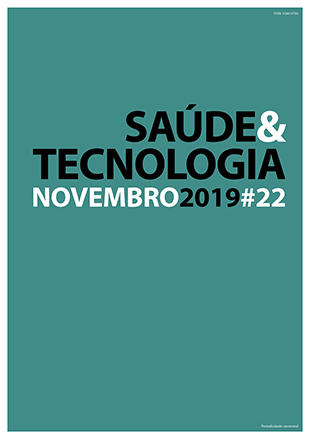Human methicillin-resistant Staphylococcus aureus (MRSA) colonization: a major public health concern?
DOI:
https://doi.org/10.25758/set.2232Palavras-chave:
Saúde pública, Methicillin-resistant Staphylococcus aureus, MRSAResumo
The World Health Organization (WHO) describes antimicrobial resistance in human pathogens as a global health challenge1. For the past decades, with the global escalation in the development of antibiotic-resistant microorganisms2 both social and scientific concerns have emerged regarding the intensive prescription of antibiotics and their widespread use in agriculture and livestock3. These antibiotic-resistant microorganisms can be found as components of bioaerosols which may occur as solid or liquid particles in the air. In numerous workplaces, particularly in the context of animal production and health care, continued exposure to bioaerosols can represent a significant health hazard for workers and for the spread of potentially pathogenic microorganisms in the community4. Several studies, performed in the past years, have provided scientific data on occupational exposure to bioaerosols in order to better understand potential relationships between exposure and health effects5.
Downloads
Referências
World Health Organization. Antimicrobial resistance: key facts [homepage]. Geneva: WHO; 2018 Feb 15. Available from: https://www.who.int/news-room/fact-sheets/detail/antimicrobial-resistance
Morris AK, Masterton RG. Antibiotic resistance surveillance: action for international studies. J Antimicrob Chemother. 2002;49(1):7-10.
Smith DL, Harris AD, Johnson JA, Silbergeld EK, Morris Jr JG. Animal antibiotic use has an early but important impact on the emergence of antibiotic resistance in human commensal bacteria. Proc Natl Acad Sci U S A. 2002;99(9):6434-9.
Walser SM, Gerstner DG, Brenner B, Bünger J, Eikmann T, Janssen B, et al. Evaluation of exposure-response relationships for health effects of microbial bioaerosols: a systematic review. Int J Hyg Environ Health. 2015;218(7):577-89.
Ghosh B, Lal H, Srivastava A. Review of bioaerosols in indoor environment with special reference to sampling, analysis and control mechanisms. Environ Int. 2015;85:254-72.
Wattinger L, Stephan R, Layer F, Johler S. Comparison of Staphylococcus aureus isolates associated with food intoxication with isolates from human nasal carriers and human infections. Eur J Clin Microbiol Infect Dis. 2012;31(4):455-64.
Rolo J, Miragaia M, Turlej-Rogacka A, Empel J, Bouchami O, Faria NA, et al. High genetic diversity among community-associated staphylococcus aureus in europe: results from a multicenter study. PLoS One. 2012;7(4):e34768.
Klevens RM, Morrison MA, Nadle J, Petit S, Gershman K, Ray S, et al. Invasive methicillin-resistant Staphylococcus aureus infections in the United States. JAMA. 2007;298(15):1763-71.
Jordan D, Simon J, Fury S, Moss S, Giffard P, Maiwald M, et al. Carriage of methicillin-resistant Staphylococcus aureus by veterinarians in Australia. Aust Vet J. 2011;89(5):152-9.
Cuny C, Wieler L, Witte W. Livestock-associated MRSA: the impact on humans. Antibiotics. 2015;4(4):521-43.
Rinsky JL, Nadimpalli M, Wing S, Hall D, Baron D, Price LB, et al. Livestock-associated methicillin and multidrug resistant Staphylococcus aureus is present among industrial, not antibiotic-free livestock operation workers in North Carolina. PLoS One. 2013;8(7):e67641.
Barton MD. Impact of antibiotic use in the swine industry. Curr Opin Microbiol. 2014;19(1):9-15.
Ribeiro E, Clérigo A. Assessment of staphylococcus aureus colonization in bakery workers: a case study. In: Vertentes e Desafios da Segurança 2017 = Views and Determinants of Safety & Security, Leiria (Portugal), 26-28 de outubro de 2017.
Hatcher SM, Rhodes SM, Stewart JR, Silbergeld E, Pisanic N, Larsen J, et al. The prevalence of antibiotic-resistant Staphylococcus aureus nasal carriage among industrial hog operation workers, community residents, and children living in their households: North Carolina, USA. Environ Health Perspect. 2017;125(4):560-9.
Sada R, Fukuda S, Ishimaru H. Toxic shock syndrome due to community-acquired methicillin-resistant Staphylococcus aureus infection: two case reports and a literature review in Japan. IDCases. 2017;8:77-80.
Fischer J, Hille K, Mellmann A, Schaumburg F, Kreienbrock L, Köck R. Low-level antimicrobial resistance of Enterobacteriaceae isolated from the nares of pig-exposed persons. Epidemiol Infect. 2016;144(4):686-90.
Ribeiro E, Pereira A, Vieira C, Paulos I, Marques M, Swart T, Monteiro A. Bacteria bioburden assessment and MRSA colonization of workers and animals from a Portuguese swine production: a case report. In: Arezes PM, Baptista JS, Barroso MP, Carneiro P, Cordeiro P, Costa N, et al. Occupational safety and hygiene VI. London: CRC Press; 2018. p. 351-4. ISBN 9781138542037
Conceição T, De Lencastre H, Aires-de-Sousa M. Frequent isolation of methicillin resistant Staphylococcus aureus (MRSA) ST398 among healthy pigs in Portugal. PLoS One. 2017;12(4):e0175340.
Negrinho A, Serrano D, Shone S, Ferreira B, Ribeiro E. Prevalência da colonização nasal por MRSA nos técnicos de Análises Clínicas e Saúde Pública num hospital de Lisboa. In: III Congresso Nacional de Ciências Médicas Laboratoriais, ESTeSL, 25 a 27 de outubro de 2019.
Faria NA, Miragaia M, de Lencastre H. Massive dissemination of methicillin resistant Staphylococcus aureus in bloodstream infections in a high MRSA prevalence country: establishment and diversification of EMRSA-15. Microb Drug Resist. 2013;19(6):483-90.
Downloads
Publicado
Edição
Secção
Licença
Direitos de Autor (c) 2022 Saúde & Tecnologia

Este trabalho encontra-se publicado com a Licença Internacional Creative Commons Atribuição-NãoComercial-SemDerivações 4.0.
A revista Saúde & Tecnologia oferece acesso livre imediato ao seu conteúdo, seguindo o princípio de que disponibilizar gratuitamente o conhecimento científico ao público proporciona maior democratização mundial do conhecimento.
A revista Saúde & Tecnologia não cobra, aos autores, taxas referentes à submissão nem ao processamento de artigos (APC).
Todos os conteúdos estão licenciados de acordo com uma licença Creative Commons CC-BY-NC-ND. Os autores têm direito a: reproduzir o seu trabalho em suporte físico ou digital para uso pessoal, profissional ou para ensino, mas não para uso comercial (incluindo venda do direito a aceder ao artigo); depositar no seu sítio da internet, da sua instituição ou num repositório uma cópia exata em formato eletrónico do artigo publicado pela Saúde & Tecnologia, desde que seja feita referência à sua publicação na Saúde & Tecnologia e o seu conteúdo (incluindo símbolos que identifiquem a revista) não seja alterado; publicar em livro de que sejam autores ou editores o conteúdo total ou parcial do manuscrito, desde que seja feita referência à sua publicação na Saúde & Tecnologia.







